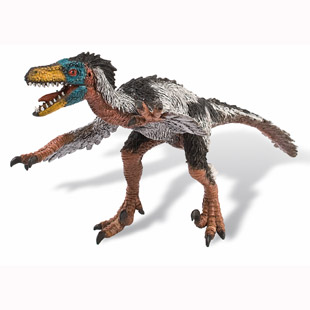Colour Coded Dinosaurs – Some New Research
Clue to the Colour of Dinosaurs
We have got used to seeing dinosaurs and other prehistoric animals depicted in glorious technicolour on our television screens, in cinemas and books, but scientists actually know very little about the colouration and markings of dinosaurs and other ancient animals. Illustrations of dinosaurs for example, are created using a basis of conjecture, supposition and comparisons with living organisms. Most sauropods (the long-necked dinosaurs), are often depicted in dull battleship grey, or browns similar to the colour of elephants, but we have no real evidence to support this. The assumption has almost always been when you are a 30 metre, 15 Tonne Diplodocus there would be little point in having camouflaged colouration, you would simply be too big to hide.
However, a paper published in the scientific journal “Biology Letters”, by a group of American researchers, sheds light on the colouration of long extinct creatures that one day may help palaeontologists understand the colours of dinosaurs.
A team of palaeobiologists and other researchers at Yale University have been studying the colour hues of 100 million year old fossilised bird feathers and their findings may permit scientists to interpret other fossil structures and to build up a colour image of long, dead animals. If the team’s interpretations are correct; then those dinosaurs that have been preserved with a covering of down or feathers could be studied and their markings and colouration deduced.
The colour of dinosaurs has long been debated, we at Everything Dinosaur run exercises in schools where we get the students to interpret fossil evidence about the size and shape of dinosaurs and the environment in which they lived. From this work we get them to draw the dinosaur and colour it in. A sort of dinosaur detective story, where the guesswork of 8 year-olds can be regarded as almost as scientifically valid as the pronouncements of the most meritorious professor.
The was some excitement when an analysis of fossilised skin from the tail area of Dakota, the superbly preserved Edmontosaurus mummy (the subject of a recent TV documentary), indicated that the animal might have had coloured bands running down its tail. Such well preserved dinosaur fossils are extremely rare and any actual colouration can only be speculated at this stage as colours will have been altered and affected by the fossilisation process.
To read more about the amazing Dinosaur Mummy Dakota: Dinosaur Mummy unlocks Duck-Billed Dinosaur Secrets.
To read the latest update on Dakota: Update on “Dakota” the recently discovered Hadrosaurine Mummy.
The Yale University team analysed fossil feathers from Brazil and Denmark and carried out comparisons with the feathers of modern birds (Neornithines). Their findings indicate that some fossilised bird feathers preserve microscopic components that when analysed and interpreted can reveal feather colouration.
The fossil feathers had stripes, these could easily be seen but it had been thought that these markings were the result of bacterial processes or geological effects during the period of preservation and fossilisation.
Could the colour of feathered dinosaurs be deduced from this work?
Commenting on the markings, Jakob Vinther one of the research team members said:
“We are quite confident that they (the markings) aren’t bacteria”
The research team targeted electron beams onto a fossil bird feather to reveal strange, sausage shaped structures that are believed to be responsible for the colour of plumage. The species of bird from which the fossil feather came from is not known, but similar microscopic structures have been found in modern feathers and their shape, composition and orientation create colours and patterns. By analysing these little packets, scientists hope to be able to build up a picture of the colouration of extinct creatures.
These structures are termed melanosomes and their analysis could help palaeobiologists understand the colours of the feathers on fossil dinosaurs, plus the colour of mammalian fur.
“We might able to get a palette of colours that we could assign to the fossils,” Jakob Vinther added.
By testing fossilised dinosaur feathers (such as those associated with the Liaoning Province of north-eastern China dating back to around 125 million years ago), for the presence of melanosomes scientists may be able to deduce the colour of these feathered dinosaurs. The likes of Caudipteryx, Sinornithosaurus and Microraptor may be revealed in glorious technicolour.
As both birds and crocodiles have colour vision, scientists have long thought that dinosaurs as close relatives of these two extant groups would also have colour vision. Being able to interpret the colouration of certain fossils will enable palaeontologists to build up a more accurate picture of what some of these animals looked like. It will also provide evidence of sexual dimorphism in species, even help to identify males and females within a species.
Having an understanding of the colours and markings of an animal will also provide clues to the animal’s behaviour. Gaudy colours may indicate the importance of displaying, perhaps for breeding, courtship or other social purposes, whereas, tones such as greens and browns would help these animals hide from predators.
How the melanosomes have survived the fossilisation process is not quite understood, most organic material, including DNA, decomposes quickly and does not survive the preservation process. However, as our understanding of genetics improves and new techniques to analyse fossils are introduced we may be able to produce accurate illustrations of long extinct animals.
Future model makers depicting feathered dinosaurs, such as those produced in conjunction with the American Museum of Natural History may be able to get close to the real colours and markings of the animals they are depicting.
Some of the Dinosaurs Featured in the Dinosaur Tube Set
Picture credit: Everything Dinosaur
Feathered dinosaurs such as Dilong, Microraptor and Caudipteryx are included along with non-feathered dinosaurs (at least as far as we know), such as Protoceratops and a sauropod.
The latest model from the Bullyland range of Germany, continues the trend to interpret many theropod dinosaurs as feathered. Although no fossils of Velociraptor mongoliensis have been found with evidence of feathers, a number of dromaeosaurs are known to have been covered in simple down or proto-feathers so Velociraptor is often depicted in this way too.
The large orbits in the skull of Velociraptor indicate that its sense of vision was exceptionally important to it, with an ability to discern colour, perhaps these animals were quite brightly coloured. Helpful for an animal living in a social group where hierarchy and status would have been important.
The Velociraptor from Bullyland

Picture credit: Everything Dinosaur
To view the Bullyland model range: Bullyland Prehistoric Animal Figures.


